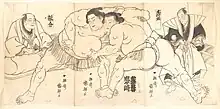| Zōgahana Heisuke | |
|---|---|
| 象ヶ鼻 平助 | |
 Zōgahana (left) wrestling Onigasaki (right) | |
| Personal information | |
| Born | unknown 1836 Tateyama, Awa Province, Japan |
| Died | March 18, 1890 (aged 53–54) |
| Height | 1.71 m (5 ft 7+1⁄2 in) |
| Weight | 103 kg (227 lb) |
| Career | |
| Stable | Tanigawa → Ikazuchi → Takasago |
| Record | 48-29-30-15 draws/1 hold |
| Debut | November, 1859 |
| Highest rank | Ōzeki (April, 1871) |
| Retired | April, 1872 |
| Elder name | Shiratama |
| * Up to date as of September 2023. | |
Zōgahana Heisuke (Japanese: 象ヶ鼻 平助, 1836 – March 18, 1890)–but sometimes called "Zōgabana" or "Sōgahana" because of the Japanese phonological tendency called rendaku–was a Japanese sumo wrestler from Tateyama, Awa Province (now Tateyama, Chiba Prefecture). His highest rank was ōzeki. He is the fifth wrestler from the prefecture to have been promoted to this rank in total. He was promoted roughly at the same time as Sakaigawa, who became an ōzeki the year before. He was also the last to hold the title until Konishiki's promotion in 1890, 25 years later.[1]
Career
Zōgahana began wrestling in Tanigawa stable. He first wrestled under the shikona, or ring name, Kuwagata Heiji (鍬形 平次) but later changed it for Todoroki Heisuke (轟 平助). In 1866, he was recruited to serve the Marugame Domain. Just before his promotion to the makuuchi division, he changed his shikona to Zōgahana (象ヶ鼻) using the kanji meaning 'elephant' (象), an unusual choice.[2] In 1871, he was promoted to ōzeki, professional sumo's second highest rank, because at the time Kimenzan, one of the leading wrestler of that time, just retired the year before, leaving the rankings unbalanced. His promotion to this rank, in just six tournaments since joining the makuuchi division, sets a precedent for extremely rapid ascent in the promotion system of the time. Zōgahana retired in April 1872 after only three tournaments at the rank of ōzeki. Since he retired at the rank of ōzeki, he was the first wrestler to retire at that rank in the Meiji era.[3]
He remained in the sumo association for some times as an elder under the name Shiratama. However, in 1873 Takasago Uragorō launched his own group for reform of the sumo association, creating a parallel association and breaching out of the traditional system with some dissatisfied wrestlers. Zōgahana decided to join the group, resulting in his formal expulsion from the association. When the Takasago group was disbanded he returned to his home without charge and in disgrace. He died on March 18, 1890, at the age of 55. His tomb is located in the grounds of the Fudō-in Henshōji temple in his hometown of Tateyama.[3]
Top division record
- The actual time the tournaments were held during the year in this period often varied.
| - | Spring | Summer | ||||
|---|---|---|---|---|---|---|
| 1865 | Jūryō #30 – |
Jūryō #30 – |
||||
| 1866 | West Jūryō #8 3–3 1d |
West Jūryō #7 3–3 3d |
||||
| 1867 | East Jūryō #4 3–3 2d |
East Jūryō #4 3–4 2d |
||||
| 1868 | East Maegashira #7 6–2–1 1d |
East Maegashira #4 4–3–3 |
||||
| 1869 | East Maegashira #2 8–1–1 |
East Maegashira #1 5–0–2 3d |
||||
| 1870 | East Sekiwake #1 5–2–2 1h |
West Sekiwake #1 4–3–1 2d |
||||
| 1871 | West Ōzeki #1 3–5–2 |
West Ōzeki #1 1–0–8 1d |
||||
| 1872 | West Ōzeki #1 Retired 0–0–10 |
|||||
| Record given as win-loss-absent Top Division Champion Top Division Runner-up Retired Lower Divisions Key:d=Draw(s) (引分); h=Hold(s) (預り) | ||||||
See also
References
- ↑ "Wrestlers from Chiba Prefecture by rank". Sumo Reference. Retrieved 29 September 2023.
- ↑ "浅坂さんの"珍四股名"〜動物編〜 - 象ヶ鼻平助". Osumo3 Magazine (in Japanese). 4 October 2022. Retrieved 29 September 2023.
- 1 2 Akira Takemori (9 August 2012). "不動院遍照密寺 (千葉県館山市) - 大関象ヶ鼻墓". Sumo Memorial Hall and Historic Sites (in Japanese). Retrieved 29 September 2023.
- ↑ "Zogahana Heisuke Rikishi Information". Sumo Reference.
Further reading
- "『大相撲人物大事典』" [Encyclopedia of Sumo Figures]. Sumo Magazine. Baseball Magazine, Inc. January 2001. p. 725. ISBN 9784583036403.
- Tadamasa Sakai [in Japanese] (1964). 日本相撲史 [History of Japanese Sumo]. Vol. 2. Japan Sumo Association. ISBN 4835455037.